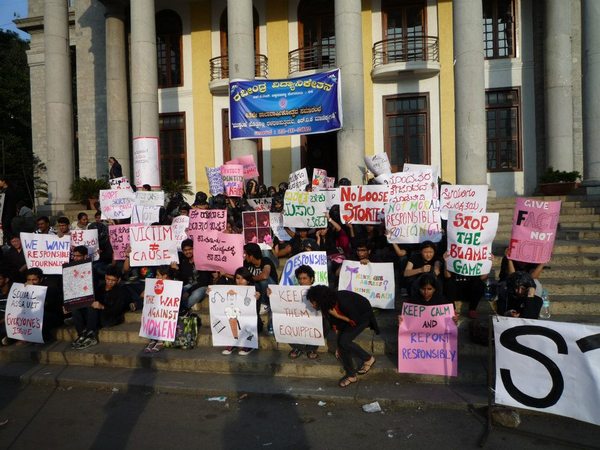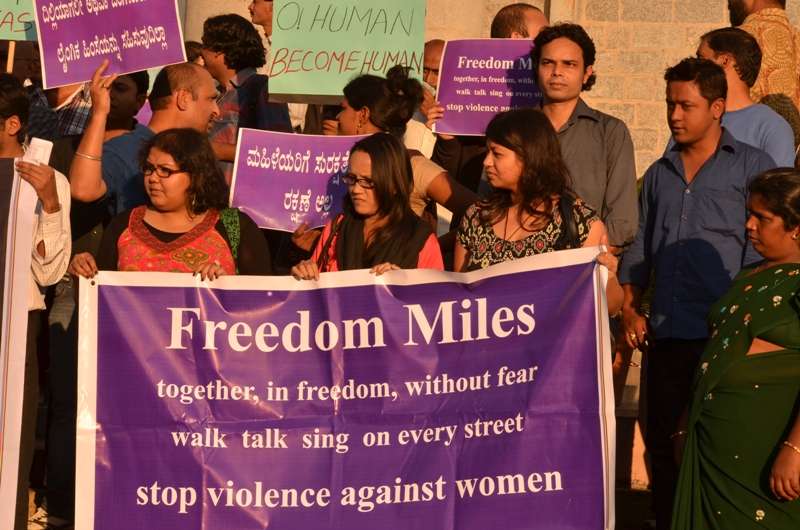The gang-rape and murder of two girls in Katra Sadatganj village of Badaun district in Uttar Pradesh on May 27 has refocused attention on the apparently never-ending problem of sexual violence in India, and the need to decisively tackle the pandemic so that women and girls can lead normal lives without the fear of sexual assault hovering like the sword of Damocles over them.
Many points have been made in the process and most of them are right. To reiterate:
Ø India, and Indian women, desperately need more toilets. Easy, safe access to toilets would render women and girls less vulnerable to sexual harassment and violence, as well as to a number of endemic health problems. Since the absence of sanitation is closely connected to not only sexual assault and ill-health but also high maternal and child mortality rates and female school drop-out rates, toilets are clearly essential for women’s survival, safety and security.
Ø The persistence of caste hierarchies, casteist prejudice and discrimination and, to make matters worse, caste-based politics and administration obviously exacerbates the situation. The use of sexual violence to perpetuate caste supremacy and subjugation has a long, inglorious history.
It is widely recognised that Dalit women are disproportionately represented among known victims and survivors of sexual violence, even as many rapes committed on women from socially and economically disadvantaged communities go unreported and/or unrecorded, thanks mainly to caste bias and intimidation.
The recent brazen, gruesome lynching of two teenaged girls in Badaun – recalling similar atrocities against African-Americans in the US up to the mid-20th Century – reinforces the widespread perception that the deadly crime had to do with caste in addition to gender, even though the girls were not Dalit but belonged to the Maurya caste, which is also marginalised in the caste-based pecking order.
Ø The perennial, intractable problem of the role of the police in tackling crimes against women, especially sexual violence, has to be urgently and effectively dealt with at least now. That their attitudes and behaviour typically constitute a major stumbling block in the path to justice has been well established over the years.
More diversity in the police force – in terms of sex, caste and community – is an important aspect of the multi-pronged strategy required to improve the responsiveness of the police to the public, including women and historically oppressed communities.
An extensive, intensive, sustained attempt to educate police personnel at all levels about their crucial role in upholding the Constitution and enforcing the laws of the land, as well as their responsibilities towards and relationship with citizens is clearly overdue.
Ø The bizarre, antediluvian statements of several prominent politicians about men, women and sexual violence would be laughable if they were not so dangerous. The troubling fact is that they are obviously mere symptoms of grim realities such as the persistently patriarchal and feudal mindsets of too many political leaders, the growing and mutually beneficial interplay between crime and politics, and the resulting impunity enjoyed by offenders, especially those who can count on political patronage.
Ø The apparent lawlessness, violence, insecurity and impunity prevailing in Uttar Pradesh and the culpability of the present regime in the state were tragically spotlighted by the atrocity in Badaun.
The subsequent spike in news reports on sexual and other crimes in UP, together with the uninformed, insensitive and inexcusable statements made by members of the ruling party -- including its president and the state’s chief minister – strengthen the common perception of UP as a runaway state.
Ø The renewed proposal by the union government to establish one-stop rape crisis centres in each district of the country by the end of the year is welcome. Of course, they must actually materialise and also have the financial and specially trained human resources required to make the projected police, medical and legal assistance, as well as short stay facilities and ambulance services, really available and acceptable to those who have suffered sexual assault.
The flip side
While all this is indeed true, other relevant facts need to be considered as well. The tendency to focus on one aspect or another of a huge, widespread and complex problem like sexual violence is reminiscent of the old story about six blind persons trying to describe an elephant, based on the particular part of the animal each is able to touch.
So, for example, it is also true that women and girls are raped not only when they go out to fields, forests or maidans to relieve themselves under the cover of darkness, but also at any time of the day in buses, trains, cars, homes, workplaces, schools, colleges, hospitals and, yes, even toilets: the body of a nine-year-old girl who was recently raped and murdered by an 18-year-old man in a dilapidated school building on the outskirts of Bangalore was found in the toilet of the school.
Likewise, it is true that women from diverse castes, communities, classes, ages, occupations and locations are targets of sexual violence. Just days after the Badaun atrocity, a female judge in her 40s was reportedly attacked inside her home in the high-security Judges’ Compound in Aligarh, despite the 24-hour surveillance provided to the colony by the Provincial Armed Constabulary. According to her family, her assailants attempted both rape and murder.
True, too, is the fact that sexual violence is used in areas and situations of conflict as a weapon of war, domination and suppression. And members of various armed forces – as well as militant groups – are among those who do the raping.
The recent horrific killing of a 35-year-old Garo woman in Meghalaya, allegedly by militants of the Garo National Liberation Army (GNLA) reportedly enraged by her resistance to their attempt to molest and rape her, is still fresh in the mind. But memories also persist of the rape and murder of Thangjam Manorama by soldiers of the Assam Rifles paramilitary force in Manipur a decade ago and the controversial rapes in Kunan Poshpora, Shopian, Pahalgam and other places in Kashmir over the years in which armed forces personnel were implicated.
It is also widely known that rape has been a regular, painful feature of communal violence in different parts of the country, including Gujarat 2002 and Orissa 2008.
The police, of course, do not need the excuse of conflict for the purpose. In a recent case, again in UP, a woman was reportedly gang-raped by four policemen, including a Station House Officer (SHO), when she went to the police station in Hamirpur to meet her husband, detained in connection with a case.
Even more recently, underscoring the violence to which members of sexual minorities are often subjected, a transgender person was not only raped by policemen in a police station in Ajmer but made to pay them a large amount of money for absolving her of the false charges on which she was taken into custody in the first place.
It is also true that if the Samajwadi Party has a preponderance of leaders who harbour and express retrograde views on rape, few other political parties, including the Bharatiya Janata Party and the Indian National Congress, can claim to be free of such neanderthals. If a Member of Parliament belonging to the Trinamool Congress party threatened to have women belonging to opposition parties raped, the BJP Chief Minister of Goa suggested that the ordeal of a woman who is raped is not as bad as that of entrepreneurs trying to start an industry. Similarly strange and unacceptable statements on the subject have emanated over the years, as well as in the recent past, from north, south, east and west.
A growing number of politicians across parties have also been accused of rape. The compilation of data on over 5,000 candidates who contested the recent Lok Sabha election by the Association for Democratic Reforms reveals that 17 per cent have declared criminal charges in affidavits submitted to the Election Commission, and 10 per cent face serious charges of rape and murder. If an SP MLA was recently accused of confining and repeatedly raping a Dalit girl (also from Badaun), a BJP MP and minister in the new union government has been summoned by a Jaipur court, along with others, in connection with the rape of a young woman.
This, too, is true: however callous, self-serving and beside the point Akhilesh Yadav’s statement about rapes taking place all over the country, and not just in Uttar Pradesh, may have been, it is a fact that cannot be denied.
In the weeks since the rape and murder of the two cousins in Badaun, there have been reports in the Bangalore press of rapes, attempted rapes and related killings in Delhi, Gujarat, Haryana, Jammu & Kashmir, Jharkhand, Karnataka, Madhya Pradesh, Maharashtra, Meghalaya, Rajasthan, Tamil Nadu and West Bengal, besides several places across UP. The press elsewhere is sure to have recorded sexual crimes in other parts of the country during the same period.

Students of NLSIU protest increasing sexual violence against women in front of the Town Hall, Bangalore in Oct 2012. Pic: N Jayaram (via Citizen Matters)
There is no doubt that the media have a tendency to latch onto certain cases in certain places at certain times and to use them as sticks to beat a particular, presently unpopular political party, leader or government with, more or less ignoring the fact that several others are also guilty as charged, and that the supposed, current epidemic of rape is not unprecedented.
A news report headlined “Rape and Murder in Uttar Pradesh,” calling attention to the fact that a “spate of exceptionally brutal rapes in the northern state of Uttar Pradesh has shocked India,” with a lead paragraph describing the assault on a 16-year-old girl when she went to the fields for her evening ablutions, could easily be mistaken for one written over the past month. However, the dateline is 17 July 2011.
Mayawati was the Chief Minister of the state at the time. According to the report, she had not visited any of the victims or their families, although she did announce a month-long campaign focusing on crimes against women. Considering the continuing spate of rapes in UP in the intervening years, albeit now under a different dispensation, the campaign was obviously not very effective. How could it possibly be?
Not by law alone
The Criminal Law (Amendment) Act 2013 – passed just months after the fatal gang-rape of a 23-year-old physiotherapy student in Delhi in December 2012, which provoked a massive, spontaneous public outcry across the country – more or less fulfilled the popular demand for a “stringent law” to deal with rape and other sexual offences. Despite the fact that it includes enhanced punishment for rape – including the death penalty under certain circumstances (a provision opposed by many women’s organisations) – the new legislation has clearly had little deterrent effect on rapists or, indeed, on law-makers or law-enforcers.

Protests in Bangalore over rising violence against women. Pic: Jim Ankan Deka via Wikimedia
Rapists seem to be figuring out fresh ways to ensure that they can get away with their crimes. The body of a young woman who was stripped and probably gang-raped before she was killed in Bareilly (UP) in early June revealed that not only had she been forced to drink acid, but her face had been disfigured with acid or petrol – obviously to make identification difficult (according to locals, this is in keeping with an increasingly familiar trend).
In the Badaun case, the police refused to act until it was too late even though the new law has strengthened the accountability of the police and other public servants for acts of omission and commission in connection with sexual offences, stipulating a minimum mandatory sentence of six months for dereliction of duty – that is, for not acting as required by the law or disobeying the law to the detriment of a woman.
The depressing fact is that after nearly 35 years of women-led activism against rape in India (leading early on to legislative action), and despite the popular uprising triggered by the December 2012 gang-rape (culminating in further legislative action), neither the frequency nor the brutality of sexual crimes seem to be on the wane. In fact, a disturbing aspect of the most savage and sadistic cases that have received the maximum media and public attention in recent times is that they appear to be inspiring copycat crimes.
Is the preponderance of gang-rapes reported from different parts of the country over the past year and a half just happenstance? Is it a coincidence that four women’s bodies were found hanging from trees in separate incidents in Sitapur, Bahraich, Moradabad and Aligarh districts (UP) respectively within a fortnight of the notorious lynchings in Badaun?
What is going on? Have we been missing the wood for the trees all along?
( Read the concluding part of this article here)

























